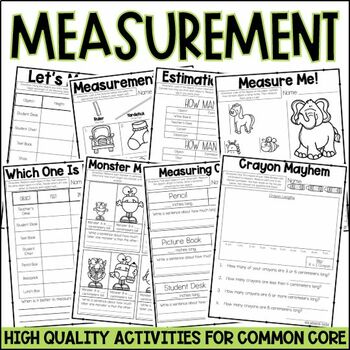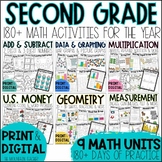Measurement Worksheets, Anchor Charts & Assessments for 2nd Grade
- PDF
- Google Apps™
- Easel Activity

Also included in
- Planning your 2nd grade math lessons for the year is EASY with this YEAR LONG bundle that includes 40 weeks of 2nd grade math worksheets, activities (printable and digital), homework, pacing guides and assessments for every common core state standard. What's Included With the 2nd Grade Math WorksheePrice $60.00Original Price $73.92Save $13.92
Description
Need some helpful measurement worksheets and anchor charts for your 2nd grade students? This 2 week unit is filled with printable and digital measurement worksheets, assessments and hands-on activities covering using a ruler, inches, centimeters, comparing lengths, length, width, height, estimating, line plots, selecting the correct tool, and more.
What's Included in the Measurement Worksheets:
- 23 Page Digital Workbook (9 Printable Worksheets PDF)
- Digital/Printable Pre and Post Test
- Teaching Guide
- Anchor Charts
- Answer Keys
Formats of Measurement Worksheets:
- Printable Black and White Worksheets
- Printable Color Worksheets
- Google Slides Workbook (with digital ruler included)
- Easel Workbook
These Measurement Worksheets Cover the Following Standards:
- 2.MD.A.1: Measure the length of an object by selecting and using appropriate tools such as rulers, yardsticks, meter sticks, and measuring tapes.
- 2.MD.A.2: Measure the length of an object twice, using length units of different lengths for the two measurements; describe how the two measurements relate to the size of the unit chosen.
- 2.MD.A.3: Estimate lengths using units of inches, feet, centimeters, and meters.
- 2.MD.A.4: Measure to determine how much longer one object is than another, expressing the length difference in terms of a standard length unit.
- 2.MD.A.5: Generate measurement data by measuring lengths of several objects to the nearest whole unit, or by making repeated measurements of the same object. Show the measurements by making a line plot, where the horizontal scale is marked off in whole-number units.
Check Out My Other Second Grade Math Worksheet Packs:
- Place Value
- Addition and Subtraction to 1000
- Word Problems
- Data & Graphing
- Measurement
- Geometry
- Money
- Time
- Arrays
- BUNDLE All Nine Units!
OR check out my Second Grade Let's Do Math Curriculum, including DAILY warm ups, turn and talks, mini lessons, weekly quizzes, unit assessments, benchmark tests, daily worksheets and so much more.
You can also connect with me for first access to my resources, giveaways and FREEBIES via: Email | Website | Instagram | Facebook | Teachers Pay Teachers







